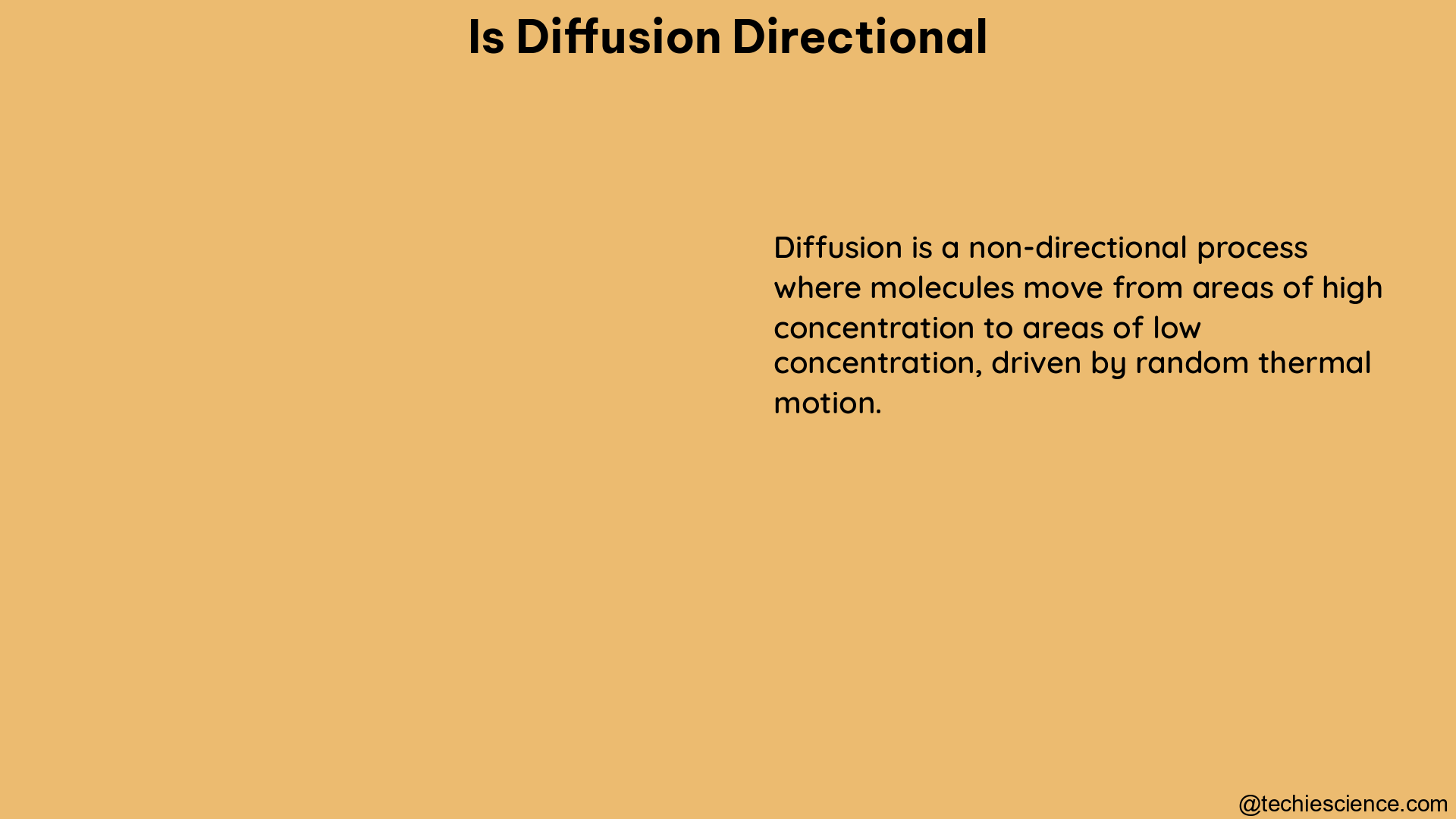Diffusion is a fundamental process in biology, governing the movement of molecules and ions across cell membranes and within the extracellular matrix. Understanding the directional nature of diffusion is crucial for comprehending various biological phenomena, from the transmission of electrical signals in neurons to the transport of nutrients and signaling molecules in tissues. This comprehensive guide will delve into the intricacies of directional diffusion, equipping biology students with the knowledge and tools to navigate this essential concept.
Fick’s First Law: The Driving Force of Directional Diffusion
Diffusion is indeed a directional process, as described by Fick’s First Law of Diffusion. This law states that the diffusion flux (J), or the rate of diffusion per unit area, is proportional to the concentration gradient (dC/dx) of the diffusing substance. In other words, the net movement of particles occurs from a region of higher concentration to a region of lower concentration.
The mathematical expression of Fick’s First Law is:
J = -D * (dC/dx)
Where:
– J is the diffusion flux (the amount of substance per unit area per unit time)
– D is the diffusion coefficient, a measure of the rate of diffusion for a given substance
– dC/dx is the concentration gradient, the change in concentration over distance
The negative sign in the equation indicates that the direction of diffusion is from high to low concentration, as the net movement of particles is down the concentration gradient.
Factors Influencing Directional Diffusion

Several factors can influence the directionality and rate of diffusion in biological systems:
-
Concentration Gradient: As mentioned, the concentration gradient is the primary driving force for directional diffusion. The greater the difference in concentration between two regions, the faster the rate of diffusion.
-
Diffusion Coefficient: The diffusion coefficient (D) is a measure of the mobility of a particular molecule or ion. Smaller, uncharged molecules generally have higher diffusion coefficients and diffuse more rapidly than larger, charged molecules.
-
Temperature: Increased temperature can enhance the kinetic energy of molecules, leading to faster diffusion rates. This is why diffusion is often more rapid at higher temperatures.
-
Viscosity: The viscosity of the medium can also affect the rate of diffusion. Higher viscosity, such as in the case of a more concentrated solution or a more dense extracellular matrix, can slow down the diffusion process.
-
Membrane Permeability: In the context of biological systems, the permeability of cell membranes can influence the directionality and rate of diffusion. Certain membrane channels and transporters can selectively allow or restrict the passage of specific molecules or ions.
Directional Diffusion in Biological Processes
Directional diffusion plays a crucial role in various biological processes:
Neuronal Signaling
In neurons, the movement of ions such as sodium (Na+), potassium (K+), chloride (Cl-), and bicarbonate (HCO3-) across the cell membrane is driven by concentration gradients established by ion channels and transporters. These concentration gradients, in turn, generate electrical signals that propagate along the neuron, enabling the transmission of information.
Cellular Respiration
During cellular respiration, the diffusion of oxygen (O2) from the extracellular environment into the cell, and the diffusion of carbon dioxide (CO2) from the cell to the extracellular environment, are essential for the efficient production of ATP, the primary energy currency of the cell.
Nutrient and Waste Transport
Diffusion is responsible for the movement of nutrients, such as glucose and amino acids, from the extracellular matrix into cells, as well as the removal of waste products, like lactic acid and urea, from cells to the extracellular space and ultimately to the circulatory system.
Signaling Molecule Transport
In the extracellular matrix, diffusion allows for the movement of signaling molecules, growth factors, and other regulatory molecules that are critical for tissue development, maintenance, and repair. These molecules can bind to specific receptors on target cells, triggering downstream signaling cascades.
Osmosis and Water Balance
Diffusion of water molecules across semi-permeable cell membranes, a process known as osmosis, is essential for maintaining the appropriate water balance within cells and tissues. This process is particularly important in the regulation of cell volume and the movement of water across the blood-brain barrier.
Measuring Directional Diffusion
Researchers employ various techniques to measure and quantify the directional nature of diffusion in biological systems:
-
Fluorescence Recovery After Photobleaching (FRAP): This technique involves photobleaching a small region of a sample and then measuring the recovery of fluorescence over time as molecules diffuse into the bleached region. FRAP provides information about the diffusion coefficient and the mobile fraction of a particular molecule.
-
Single-Particle Tracking: This method involves tracking the movement of individual molecules over time, allowing researchers to directly observe and quantify the directionality and rate of diffusion.
-
Diffusion Magnetic Resonance Imaging (MRI): Diffusion MRI uses magnetic field gradients to measure the diffusion of water molecules in tissues. This technique is particularly useful for studying the diffusion of water in the brain and other organs, providing insights into the structural and functional properties of biological tissues.
-
Microfluidic Devices: Microfluidic platforms can be used to create controlled concentration gradients and study the directional movement of molecules or cells in response to these gradients, providing a powerful tool for investigating diffusion-driven processes.
Conclusion
Diffusion is a fundamental and directional process that is essential for the proper functioning of biological systems. Understanding the principles of directional diffusion, as described by Fick’s First Law, and the factors that influence it, is crucial for biology students to comprehend a wide range of biological phenomena, from neuronal signaling to cellular respiration and beyond. By mastering the concepts presented in this comprehensive guide, biology students will be well-equipped to navigate the complexities of directional diffusion and apply this knowledge to their studies and research.
References:
- Molecular Diffusion – an overview | ScienceDirect Topics. (n.d.). Retrieved July 9, 2024, from https://www.sciencedirect.com/topics/earth-and-planetary-sciences/molecular-diffusion
- From Diffusion to the Diffusion Tensor – Radiology Key. (2016, November 20). Retrieved July 9, 2024, from https://radiologykey.com/from-diffusion-to-the-diffusion-tensor/
- Diffusion I | Chemistry – Visionlearning. (n.d.). Retrieved July 9, 2024, from https://www.visionlearning.com/en/library/Chemistry/1/Diffusion-I/216
- Diffusion Flux – an overview | ScienceDirect Topics. (n.d.). Retrieved July 9, 2024, from https://www.sciencedirect.com/topics/biochemistry-genetics-and-molecular-biology/diffusion-flux
- Diffusion vs. Concentration Gradient : r/biology – Reddit. (2024, May 22). Retrieved July 9, 2024, from https://www.reddit.com/r/biology/comments/1cyaush/diffusion_vs_concentration_gradient/

Hello, my name is Kriti Singh from Agra. I have completed a post-graduation degree in Biotechnology and a B.Ed. degree. Biology is my favorite subject since childhood and I never felt tired or bored with this particular subject. As I have an inquisitive personality, always been curious and fascinated to know more about life and nature.
Let’s connect through LinkedIn: